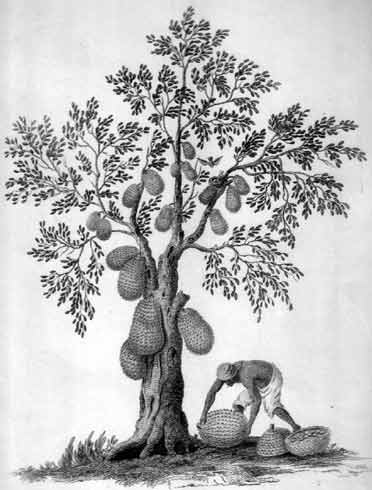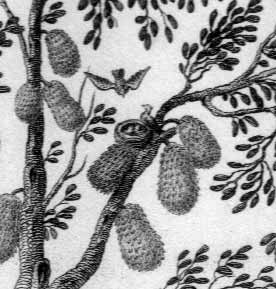The Benevolent Jak

|
by Godwin Witane
The Daily News (Colombo) Tuesday July 09, 2002
The Jak tree is called a kiri gaha as the slightest damage done to its bark would yield ample sap white in colour like milk. This tree is believed to be lucky to have in one's garden. The tree is of two kinds called waraka and vela depending on the strength and taste of the fruit when ripe. The bulbs of the fruit are sweet to taste but the waraka is harder to bite than the vela which is very weak and slippery to touch.
The indigenous Jak tree, Kos or Herali in Sinhala is a predominant hardwood tree with a thick canopy of oval shaped dark green foliage growing up to a height of 60-70 metres bearing seasonal fruit with a prickly coated outer skin.
The inside of the fruit bears a cluster of globular ovaries containing a hard seed and named Madulu. How this fruit came to be named as Herali is explained in the following episode. In ancient times when jungle folk depended on tubers and yams as their staple diet along with hunted game, there came a severe drought reducing the ground into a hard concrete mass that the people found it beyond their means to dig for yams in the forest with their pointed wooden implement. At this time jak fruit was found in abundance growing wild on the many trees everywhere unknown to the people their edible qualities.
A village woman or gama mahage was unable to withstand the hunger and, deciding it was better to die of consuming this unknown fruit than dying of hunger, plucked a seasoned jak fruit and after skinning it boiled its contents. With trepidation she ate the boiled fruit to her hearts content and subsequently finding no evil effects of the food taken, she left off a portion for her husband who had gone hunting. On his return he ate the boiled fruit offered to him by his wife and finding it most palatable inquired from the wife what it was. When she revealed that it was jak fruit, he in endearing terms called her Hera Liya meaning rouge wife. Thereafter this fruit came into use as a harmless food and was named Herali.
The Jak tree is called a Kin Gaha as the slightest damage done to its bark would yield ample sap white in colour like milk. This tree is believed lucky to have in ones garden. The tree is of two kinds called Waraka and Vela depending on the strength and taste of the fruit when ripe. The bulbs of the fruit are sweet to taste but the Waraka is harder to bite than the Vela, which is very weak and slippery to touch.
In village lore an indolent and lazy person is named as a Vela fruit. Sometimes a comely damsel is described as a ripe jak bulb or Waraka Madula. The jak fruit grows on the trunk of the tree held by strong stems. The trees bear fruit in a couple of years while there is a variety that bear fruit within eighteen months. This kind is preferred for propagation. The pulp of the jak fruit in its early stages is white in colour while it turns yellow on maturity. When people test the fruit for plucking it is done by punching a hole in the fruit with a pointed knife to bring out pieces of the bulb to see whether it is yellow in colour when yellow it is fit for plucking. The jak tree is a protected tree and therefore an official permit is required either to fell a tree or transport timber. The timber is used in making furniture frames and as rafters and beams in he construction of houses. The wood of the Waraka tree is considered to that of Vela.
Mr. Arthur V. Dim, a philanthropist of Panadura was the pioneer who vigorously campaigned for the propagation of jak trees in every household throughout the island and was referred in endearing terms as 'Kos Mama'. He traveled the length and breadth of the island visiting towns and villages preaching the value of this food tree. He sent parcels of jak seeds to anyone anywhere who called for them free of charge. He had a stall in front of his house with jak seedlings in small bags for anyone to remove free and propagate wherever they pleased.

He was the person who initiated the Tree Planting Campaign on a national scale from early times. While substituting jak as an alternate for rice for the poor villager this tree has a medicinal value in its leaves as an antidote for diabetes. The ripe leaves of a Waraka tree is dried and when ground into a powder can be taken as a beverage which would reduce the sugar content in the blood of diabetic patients. The root of the Waraka tree is used as a dye in dying the robes of monks to appear ochre or yellow in lasting colour. The sap of the jak fruit is used as a gum and some villagers stick it in knobs on a rafter or the kitchen wall to serve in medicinal purposes. The uses of the jak fruit are varied, that the tender fruit is called Polos which is cooked as a delicious curry.
The half matured fruit which is white in colour is minced into small pieces wholesale and made into a Mellun with added scraped coconut and condiments. The bulbs or ovaries of the matured fruit is cut and boiled with the seed and eaten with coconut and gravy. It is also cooked as a curry with coconut milk and condiments added. Jak fruit is a boon to poor people who cannot afford two meals of rice a day. This was the mainstay of poor villagers during the early nineteen twenties when Sri Lanka was riddled with a famine and scarcity of rice. People resorted to jak and yams to sustain life.
Jak pulp and seeds can be preserved for long periods when boiled and dried in the sun or above the hearth when they are called Atu Kos. The unspoilt seeds are also preserved in earth and stored in the corner of the kitchen to be boiled and eaten as, a food called Wala Kos. Raw jak seeds form a delicious curry called Kalu Pol Maluwa relished by one and all. First the fresh seeds are washed and boiled.
Then the boiled seeds are slightly smashed for the absorption of condiments which constitute fried scrapped coconut ground with curry powder. The ripe jak fruit is eaten as a dessert but people prefer Waraka to Vela.
| Living Heritage Trust ©2020 All Rights Reserved |